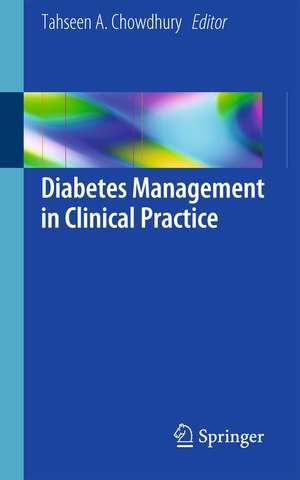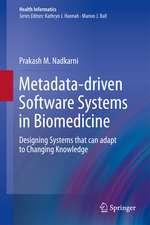Diabetes Management in Clinical Practice
Editat de Tahseen A. Chowdhuryen Limba Engleză Paperback – 5 mar 2014
Preț: 361.06 lei
Preț vechi: 380.07 lei
-5% Nou
Puncte Express: 542
Preț estimativ în valută:
69.11€ • 75.09$ • 58.09£
69.11€ • 75.09$ • 58.09£
Carte tipărită la comandă
Livrare economică 21 aprilie-05 mai
Preluare comenzi: 021 569.72.76
Specificații
ISBN-13: 9781447148685
ISBN-10: 1447148681
Pagini: 200
Ilustrații: XIV, 138 p. 17 illus., 10 illus. in color.
Dimensiuni: 127 x 203 x 15 mm
Greutate: 0.23 kg
Ediția:2014
Editura: SPRINGER LONDON
Colecția Springer
Locul publicării:London, United Kingdom
ISBN-10: 1447148681
Pagini: 200
Ilustrații: XIV, 138 p. 17 illus., 10 illus. in color.
Dimensiuni: 127 x 203 x 15 mm
Greutate: 0.23 kg
Ediția:2014
Editura: SPRINGER LONDON
Colecția Springer
Locul publicării:London, United Kingdom
Public țintă
Professional/practitionerCuprins
1. Preventing diabetes.- 2. Preventing diabetes complications: non-glucose interventions.- 3. Glycaemic therapy for diabetes.- 4.Preventing and managing renal disease in diabetes.- 5. Managing diabetic foot disease.- 6. Managing diabetes in hospital.
Recenzii
From the reviews:
“The book, which summarizes the entire spectrum of care in diabetes, with information from experts in the field, is especially useful for practicing clinicians as it seamlessly incorporates information from landmark studies. … the book is written for practicing clinicians, and it is appropriate for residents, general medicine practitioners, family medicine practitioners, and endocrinologists. Each chapter is written by respected practicing endocrinologists who are credible authorities in diabetes care.” (Malini Soundarrajan, Doody’s Book Reviews, May, 2014)
“The book, which summarizes the entire spectrum of care in diabetes, with information from experts in the field, is especially useful for practicing clinicians as it seamlessly incorporates information from landmark studies. … the book is written for practicing clinicians, and it is appropriate for residents, general medicine practitioners, family medicine practitioners, and endocrinologists. Each chapter is written by respected practicing endocrinologists who are credible authorities in diabetes care.” (Malini Soundarrajan, Doody’s Book Reviews, May, 2014)
Notă biografică
Dr Tahseen Chowdhury, the editor, is lead clinician in the department of diabetes and metabolism at the Royal London Hospital, East London. He runs a large specialist diabetes and metabolism unit, dealing with diabetes particularly among the Bangladeshi community of Tower Hamlets. Dr Chowdhury has a research and clinical interest in diabetes in South Asians, and has authored over 100 publications, including a patient book entitled Diabetes in South Asian people: Explained. He qualified from the University of Birmingham and trained in Birmingham and Manchester, before becoming a consultant physician in 2000.
Textul de pe ultima copertă
Diabetes Management in Clinical Practice provides a much-needed succinct overview of the advances in the management of diabetes and its complications. Using an evidence-based approach, the authors review relevant trials and discuss prospects for future therapies and avenues of research.
Written by experts in the field for a global audience, Diabetes Management in Clinical Practice is a practical guide for diabetologists and endocrinologists, family practitioners, specialist nurses, dietitians and podiatrists.
Written by experts in the field for a global audience, Diabetes Management in Clinical Practice is a practical guide for diabetologists and endocrinologists, family practitioners, specialist nurses, dietitians and podiatrists.
Caracteristici
State of the art, evidence-based review of current practice and important topics in diabetes management Key points summary for each chapter Suitable clinical pathways and guidelines suggested?









